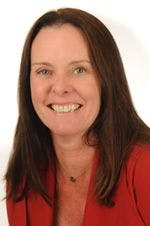HBA's Woman of the Year 2020: A Motivated Mission
For Sandra Horning, this year's Healthcare Businesswomen’s Association Woman of the Year, harnessing the patient experience has been the driving force in a career-spanning-and service-focused-mission to fight disease and accelerate the delivery of new medicines.
Setting Goals, Meeting Needs: For Sandra Horning, rooted as a practicing oncologist, researcher, and professor, harnessing the patient experience has been the driving force in a career-spanning and service-focused mission to fight disease and accelerate the delivery of new medicines
It only takes a second to know that Dr. Sandra Horning is a Midwesterner at heart. Her innocent accent recalls the fact that she grew up in Creston, Iowa. But Horning’s childhood was far from quiet.
Horning unwittingly learned about medicine at an early age. After experiencing several serious family illnesses, she underwent a couple of unrelated surgeries herself at the age of six. While the situation was scary, Horning hung tough and was able to find a silver lining. Her admiration for her pediatrician, combined with the
Sandra Horning

mysterious nature of medical science fostered a lifelong interest in the field.
“Medicine seemed to me to be a really exquisite blend of science and helping people,” says Horning, named this year’s Woman of the Year by the Healthcare Businesswomen’s Association (HBA). “That was very attractive to me.”
She also noticed all the doctors were men and all the nurses were women at the time. It was then that she announced she wanted to be a doctor. Instead of feeling threatened, Horning embraced the challenge.
Just as she was planning to enter medical school at the University of Iowa, Horning was dealt another health blow: This time she received news that her father had terminal cancer. The experience again pushed her forward and fortified her resolve to become a doctor.
Horning next spent three years in New York completing her internship and residency in internal medicine. From there, she headed to Stanford University for her oncology fellowship, where she remained as a researcher, professor, and practitioner for nearly 30 years.
“In the school of medicine, you basically do three things,” says Horning. “One is you educate. For me, it was about educating trainees who were already physicians specializing in oncology and in my area of expertise, lymphoma. You do research, and the research I did was clinical research, which means involving patients. And I practiced oncology in a very active clinic, taking care of patients in the hospital as well.”
Timing is everything
Though she spent most of her life in medicine, as a physician, academic, and educator, Horning’s path to pharma wasn’t a traditional one. In fact, she only moved into the industry in the last 10 years.
“It was a rather late transition compared to many,” she says. “But for me, it was really about the timing being right.”
Horning’s career experience had prepared her for the move, though, and she was ready to take on a leadership role. She had held several significant leadership positions at Stanford, nationally and internationally, and served as president of the American Society of Clinical Oncology (ASCO) from 2005-2006.
Career snapshot; click to enlarge
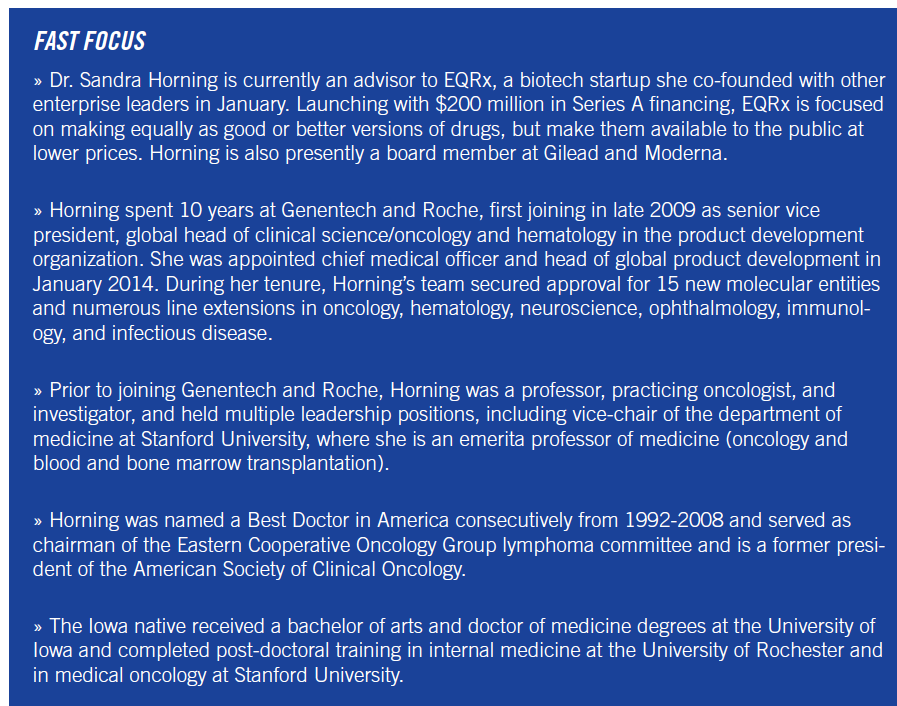
The combination of her drive to lead and the opportunity-filled field of oncology made Horning feel that the timing was right.
“I lived through the valley of death in terms of the lack of progress in oncology treatments to emerge in what I would call the golden age of oncology, where the science had developed and ripened to a place where we could really help patients through the development of highly active drugs,” she says. “That was very exciting for me.”
As a senior investigator in two Phase III trials for the drug Rituxan, which was developed by Genentech and Roche, Horning appreciated the major, positive impact the drug had on her patients and her practice. She was eager to continue and grow that type of work.
“It was really that experience that compelled me to want to do it again, make more drugs like Rituxan available to patients,” she says.
Breaking barriers
While Horning’s personal past wasn’t easy, her professional journey was likewise challenging. She and her female colleagues were often met with resistance as they rose through the ranks. She describes women in medicine at that time as “pioneers.”
“I feel that I was constantly underestimated in terms of whether I would achieve my dream of being a physician-whether I would or could excel in medical school, residency, or fellowship,” she says. “It was a continuous theme when I got into the academic ranks: whether I would succeed in getting tenure; whether I could secure grants; whether I could be an academic leader; and later, whether I could successfully transition to industry, or be a strong people leader as well as a technical expert.
“On the other hand, I would say I was also supported, because a few significant champions opened doors for me and made my eventual success possible. And I’m very grateful for that.”
Horning’s challenges extended beyond just being a woman. She faced questions of credibility, having moved directly from academia into a leadership position in pharma, becoming the global head of oncology

for Genentech and Roche in late 2009, following a recommendation from a former colleague.
“I obviously had a steep learning curve and had to navigate that at the same time that I was establishing my leadership,” she says.
It didn’t help that Horning joined Genentech shortly after the acquisition by Roche. Integrating two cultures with very proud histories was also something to overcome, she says.
After being head of oncology for four years, Horning was faced with another formidable learning curve when she moved into the chief medical officer role. Leading the 5,000-person global product development organization required her to reach beyond her expertise in oncology and hematology to oversee all therapeutic areas and all aspects of development.
“What kept me going was my passion for the field of medicine, for patients, for wanting to make a contribution to society, and the purpose I derived from long-ago personal health issues-knowing how these affected my family and me, and wanting to make it better for others,” she says.
Launch and learn
Horning’s strong science background, excellent work ethic, and thirst for knowledge also helped her overcome these obstacles.
“Science is the core of Genentech and Roche’s business, so Sandra’s impressive clinical science background was a natural fit,” says former colleague Gisela A. Paulsen, MPharm, senior vice president, global head, product development clinical operations at Genentech and Roche. “What made her an exceptional leader was how she paired her intellectual capacity with her innate ability to educate. Because of her experience in academia, Sandra came to Genentech and Roche with the technical knowledge and the ability to teach those around her.”
During her tenure, Horning’s teams secured approval for 15 new medicines and many more new indications for approved medicines. Two additional therapies are expected to receive FDA approval this year. When it comes to being successful in drug development, Horning says the most important ingredient is having a novel drug that addresses an unmet medical need. “Once you have a great product, it’s really being able to tell the story of the medical value so that it’s widely recognized and clear,” she says.
Other strategies Horning suggests include:
- Considering access and affordability very early in development and building that story concurrent with the drug’s development.
- Identifying appropriate physician champions, educating them, and partnering with them.
- Having a strong commercial team at the time of the launch.
“Sandra is one of the brightest persons I know,” says Paulo Fontoura, another former colleague, today senior vice president and global head of development for neuroscience medicines at Genentech and Roche. “The depth of her knowledge about anything is just amazing. She has a true curiosity about things and doesn’t really rest
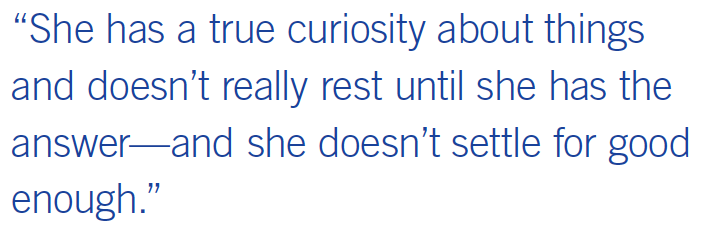
until she has the answer-and she doesn’t settle for good enough.”
Fontoura describes Horning as being “comprehensive” when it came to researching an unfamiliar topic. She wouldn’t just educate herself by reading articles, for example. She also saw the value in interacting with and learning from others.
“Sandra always made sure to listen to a lot of people,” says Fontoura. “She’d listen to all the experts and ask really deep questions to try and find out as much as possible. She was somebody who was open to feedback and other views, but she would certainly make up her own mind in the end.”
Patient perspective
In 1996, Horning had to face the realities of cancer from a new angle when she was diagnosed with breast cancer.
“[Given my] experience with my family and all my experience with my patients, as well as my knowledge of oncology, I kind of expected to have cancer at some point in time,” says Horning. “What surprised me is that it occurred so early in life, when I still had children at home.”
While her knowledge of the field was certainly useful, Horning says it was her patients that really made a
Sandra Horning high fives a colleague after being announced as 2020 HBA Woman of the Year in January.

difference. “Going through cancer treatment while I continued to practice created a very special bond with them,” she says.
As an oncologist, Horning had witnessed many of her patients undergo a personal epiphany during their treatment, often expressing ways they planned to do things differently in their lives. Horning didn’t feel like she had to change her path, however. For her, it was all about “doubling down.”
“It did help me to better understand the fear of death, the desire to live,” she says. “One of the first projects that I worked on in my academic career involved the curative treatment of young patients, where I focused on their fertility after treatment and their ability to maintain healthy lives as survivors. Survivorship has been something that has interested me throughout my career. When I was president of ASCO, we set up some of the survivorship programs, and it resonated that I was a survivor myself.”
The journey helped Horning realize how much life there is to live after survival. “That’s really increased my passion for not only wanting to develop curative treatments for patients, but also to focus on quality of life and survivorship,” she says.
Motivated medicine
Horning’s personal background and experience in clinical practice helped her keep patients at the forefront of every decision and prompted her to consider what the right thing for patients was during the drug development process.
“We had this motto, ‘Patients are waiting,’” she says. “Especially when patients have a really serious or terminal disease, every hour, every day, every week that goes by is important. So we focused a lot on acceleration, how fast we could get medicines developed and launched and in the hands of physicians. We had examples where patients were literally waiting, and we were able to deliver our new medicines within hours of approval.”
Horning’s responsibility to patients was even evident during moments of failure.
“Once, when we had a trial that did not work, her first reaction was to say, ‘I’m so sorry, because patients were really counting on this,’” says Fontoura. “What mattered to her was not the scientific success or progression and milestones, it was patients who were waiting for something, and we didn’t manage to give it to them. That really drove home what her value chain was: First of all, the patients.”
Sandra Horning presenting to colleagues.
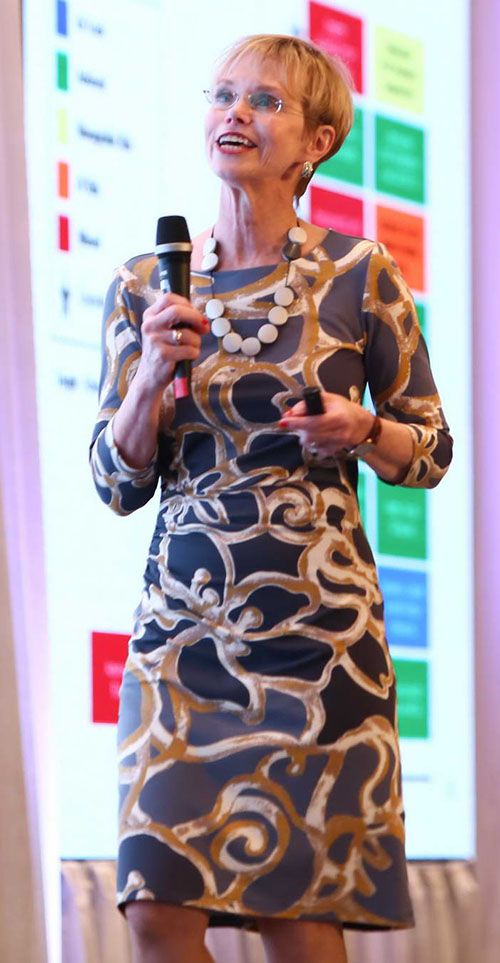
In an effort to streamline the development process, Paulsen recalls one of Horning’s boldest moves: a complete overhaul of the teams that manage molecules through Genentech and Roche’s development lifecycle.
“She pushed the organization to work in new ways, adopt iterative work processes, and embrace learning over perfection,” says Paulsen. “Her example catalyzed a 5,000-person organization to initiate a series of initiatives aimed at accelerating every aspect of the development process, from protocol writing to clinical trial execution to regulatory filings. The cumulative impact of these efforts has shortened the previous time for development by several months to date, and we are not done yet.”
As part of Horning’s initiative to bring drugs to market more quickly, she and her team supported the creation of new regulatory pathways, including FDA’s breakthrough designation. Genentech and Roche led the industry with 32 new breakthrough designations across a variety of therapeutic areas in just seven years. They also pioneered a new regulatory endpoint, pathologic complete response, which allows for early approvals in early stage breast cancer.
“Sandra was among the pioneers cooperating with the FDA on faster ways to develop medicines, with an ethical focus on getting these to patients as quickly as possible,” says Fontoura. “She worked closely with other key drivers for this to happen.”
Once again, it seems timing played a role in Horning’s success. At the time she approached FDA, there was a growing buzz around oncology. Research on promising new mechanisms was prolific. Regulators also knew patients facing lethal cancers were waiting for more options and didn’t have time to waste. This, perhaps, created an openness to think about new pathways, says Fontoura.
“I think regulators, pharma, and the community generally saw this as an opportunity,” he says. “This has since opened up [opportunities in] other therapeutic areas, and that is really exciting. It’s one of those things when we look back, that people will say, ‘This was a turning point’ in the regulatory process, when people recognized that the one-size-fits-all ends up not fitting anyone and that you really have to take a different approach.”
Former colleague Quita Beeler Highsmith, vice president and chief diversity officer at Genentech, sees Horning as a “visionary, mentor, and trailblazer.”
“I have witnessed firsthand how Sandra can be a game changer for this industry,” says Highsmith. “She has influenced patient outcomes by leading a record number of industry breakthrough therapy designations, has served as the American Society of Clinical Oncology president, and her leadership allowed for Genentech to be a driving force to bring more diverse patients into clinical research.”
Leading by example
Horning’s sense of service transcends her ability to connect with patients; it has also allowed her to establish herself as a respected leader in the industry.
“Being an effective leader in today’s environment means having a service mindset,” says Horning. “An effective leader needs to have a vision; be an architect of the strategy and create the environment where molecules and people thrive; build a team of A players; and serve as a coach to focus on the success of others, the organization, and the molecules.”
In addition to Horning’s scientific excellence and care for patients, Fontoura believes her ability to change has been integral to her success-not just having the courage to change herself but the power to catalyze change in others.
“She was willing to let go and push others to the forefront,” he says. “When you have such high standards and work ethic, your first instinct is to do it yourself. But she really was able to transform herself and inspire others to do the same. I think she found that secret of great leadership, which is that sometimes when you step back, you create space for others to multiply your impact.”
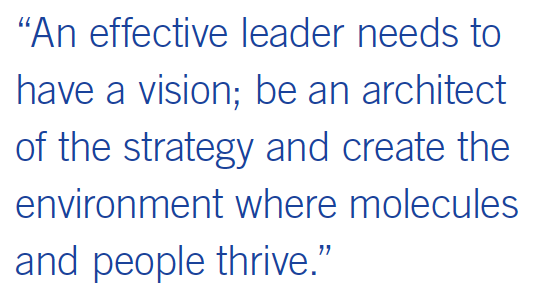
Horning helped coach and develop many leaders at Genentech and Roche. “In many ways, that’s probably part of her legacy that’s going to outlive her, perhaps even more than the scientific one,” says Fontoura.
Among those colleagues were a number of women who identified with some of the same professional challenges Horning faced throughout her professional journey and welcomed her example. Horning was now in a position to pay it back and inspire other women in the industry.
“In the field of science, it is very important to recognize women thought leaders that are making extraordinary breakthroughs to drive science and medicine for the next generation of physicians and patients,” says Beeler Highsmith. “What I admire most about Sandra is her authenticity, her drive to make a meaningful difference for patients, and her role-modeling of what it means to be a bold leader. Plus, she is a style icon.”
New beginnings
Toward the end of 2019, Horning felt satisfied with what she had accomplished at Genentech and Roche and decided it was time to begin a new chapter of her life. In January, she joined forces with industry visionaries as a co-founder of EQRx, a company committed to making innovative medicines available to the public at lower prices, where she continues to be an advisor. In February, she joined Gilead Sciences and Moderna as a board member.
“I felt the time was right for me to move into a third act, another area of life where I felt like I could continue to contribute and give back,” she says. “What I want to do is be of service to the management and executive teams of new and established biotechnology companies. I’d like to bring my expertise and leadership experience to assist companies in making great medicines for patients.”
Though Horning has traveled a long way to get to this point in her career, it’s her sincere and unwavering passion for medicine, which blossomed early in life, that still keeps her going today.
“One of the most devastating things for me in life was losing my father at a young age,” she says. “Witnessing that loss with its permanent impact on me and my family, and then going on my own journey of illness, followed by the exhilaration of restored health and the ability to live a full life after a serious illness-those are poignant and precious experiences that continue to motivate me today.”
Elaine Quilici is Pharm Exec’s Senior Editor. She can be reached at equilici@mmhgroup.com


.png&w=3840&q=75)

.png&w=3840&q=75)



.png&w=3840&q=75)



.png&w=3840&q=75)


